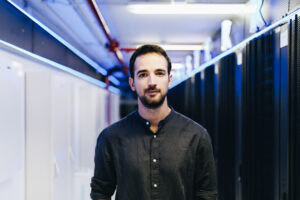CESGA investigates new quantum algorithms and tests them by making the QMIO and FinisTerrae III work together
The coexistence between quantum and classical computers is the only possible formula, at least for the time being, to make the most of the quantum advantages in the current technological environment. More capacity, more speed, and greater efficiency to solve complex problems in scientific and strategic fields at the industrial level. CESGA contributes to this milestone with its project for the design and implementation of quantum algorithms in a distributed infrastructure, in which classical and quantum computers join forces
Technological progress does not always mean sweeping away the old when something new appears. The most innovative technologies coexist with the classical ones, sometimes while the new ones mature enough to become hegemonic, and at other times in a symbiosis that is meant to last. An example of the first case is DVD and streaming platforms. The second case is clearly illustrated in the field of computing.

Daniel Faílde
Are quantum computers expected to replace classical computers, and will we start working from laptops with qubits instead of bits? The unanimous answer from the experts is no, at least not in the short or medium term. The research community agrees on the coexistence of classical and quantum computing, a combined effort to reach unprecedented problem-solving levels.
This is because, so far, it has been theoretically demonstrated that quantum computers are capable of performing certain tasks faster than classical computers. Sometimes, such gain is exponential, as in the case of the algorithm developed by Peter Shor, capable of factoring large integers very efficiently compared to classical methods. “However, although quantum computers can perform any operation that conventional computers do, this is not necessarily the most efficient thing,” asserts Daniel Faílde, a researcher at the Galicia Supercomputing Center (CESGA). “This means that we can think of quantum computers as superaccelerators for certain tasks and their purpose is going to be to work together with classical computers to solve problems that require quantum resources.”
This is the context of the project that Faílde and his team are carrying out at the center’s Department of Applications and Projects to design and implement quantum algorithms in a distributed infrastructure, in which classical and quantum computers work together to solve problems. The availability of both technologies at CESGA, the classical supercomputer FinisTerrae III, and the quantum computer QMIO, are very important enabling factors for this research. “The key issue is to know which operations need to be performed with QMIO and what is the most efficient way to do so,” says Faílde.
From algorithm to execution
Algorithms can be defined in simple terms as the instructions given to a computer so that it can perform a task, such as solving a problem. The first quantum algorithms were devised between the late 1980s and early 1990s. Since it was impossible to implement them on the first quantum computers (dating from the beginning of the 21st century), instead of waiting for machines capable of executing them successfully to be developed, hybrid algorithms have been generated in recent years that make it possible to take advantage of the quantum benefits thanks to the cooperation between the currently very sophisticated classical computers and the incipient quantum computers.
“One of the main goals of our project is to develop and enhance these algorithms to solve problems in strategic sectors,” explains Faílde. The hybrid algorithms they work with are variational quantum algorithms, whose execution depends on optimization on classical computers. These algorithms are friendlier for current devices, but they have problems such as falling into local minima, i.e., getting stuck in a solution without this being the best possible one. “That’s why the challenge is to devise new quantum algorithms or enhance existing ones. It’s a very exciting area of research where one has to leverage the resources at one’s disposal in the most efficient way possible to gain an advantage.”
 The design of the instructions –the algorithms– is only one part of the project, as the team is also investigating the best way to execute them by adapting them to the current state of technological development, with quantum computers still being of moderate size and not error-free.
The design of the instructions –the algorithms– is only one part of the project, as the team is also investigating the best way to execute them by adapting them to the current state of technological development, with quantum computers still being of moderate size and not error-free.
Another paradigm they are working on is distributed quantum computing. “That is, how to adapt quantum algorithms, which were originally intended for an infrastructure with only one quantum computer, to a network in which there are several. Today, the road map of large companies such as IBM is no longer to build machines with millions of qubits, but to make them with an intermediate number of qubits and connect them both classically and quantumly,” explains the CESGA researcher. Returning to the topic of algorithms, this involves adapting original quantum algorithms to run efficiently on this hybrid infrastructure.
“It sounds promising and it is, though it must be taken into account that, unlike the first quantum algorithms, some of the algorithms adapted to current quantum devices, the variational quantum algorithms, have not yet demonstrated an obvious improvement over their classical counterparts, in addition to dealing with other problems,” Faílde clarifies. “That’s why we’re currently working on improving them or devising others, while advances in hardware continue in parallel.”
Solutions for tangible problems
The area in which quantum computing far outperforms classical computing is in tackling large problems, since it can process and handle enormous amounts of information much more efficiently. Whereas classical computers must examine all possibilities one at a time, quantum computers use principles such as superposition and entanglement to explore multiple solutions at the same time. This makes them ideal for complex problems which would take centuries on a classical computer and are solved much faster on a quantum infrastructure.
“In some problems, such as the design of materials or drugs, the number of potential configurations grows exponentially and, in most of them, when using classical computers it is inevitable to have to settle for approximations,” illustrates Faílde, referring to the fact that, beyond a certain dimension, classical computing can only offer estimates with a considerable margin of error that in an industrial environment can entail big differences in terms of efficiency and profitability.
The experimental targets for the CESGA team are two kinds of problems with the following characteristics: problems with highly correlated systems and combinatorial problems. “The beauty of this is that finding solutions to such problems can materialize in an advantage for strategic sectors.” As examples of applicability, he mentions industrial optimization; the design of new materials, batteries, and superconductors; and the simulation of protein folding, very useful in the discovery of new drugs.
The project, which is part of the Complementary Quantum Communication Plan (PCCC), continues its theoretical development though the exploration of use cases has already begun to test both the design and adaptation of algorithms and the most efficient way to scale problems. “A proof of the interdisciplinarity of these algorithms is CESGA’s collaboration with Hijos de Rivera on a completely new use case of molecule identification,” explains Faílde.
The quantum future
“Quantum computing has the potential to revolutionize our world. And that is why it is necessary to dedicate resources and continuity to it. It is vitally important that these projects in quantum technologies have continuity if we want to be there. Having experts in this field when the technology becomes more mature requires years of dedication,” explains Daniel Faílde, who points to the complexity of this new paradigm as one of the challenges to be overcome in order to develop all this potential in the future. “Taking advantage of quantum computing to solve a problem or devise new algorithms requires an understanding that is sometimes difficult to achieve in the quantum world.”
In his view, advances in hardware are the other pillar that, along with knowledge, can generate the context needed to truly make the most of this new computing paradigm. “Processors must continue to evolve. It is only a matter of time before a clear advantage is achieved with quantum computers.”
Research in a field with such large and complex challenges is already a full-fledged long-distance race and the pace has to be fast with permanent alertness. “It’s frenetic and competitive work. Keeping up with advances in quantum computing is of the essence. It’s easy to say, but every day dozens of new articles and papers appear and we must be able to filter out the really relevant ones,” assures the CESGA researcher.
Contact: dfailde@cesga.es
Web: https://www.cesga.es/daniel-failde-balea/
Publications:
Faílde, D., Viqueira, J.D., Mussa Juane, M. et al. Using Differential Evolution to avoid local minima in Variational Quantum Algorithms. Sci Rep 13, 16230 (2023). https://pubmed.ncbi.nlm.nih.gov/37758791/
Barral, David, et al. “Review of distributed quantum computing. from single qpu to high performance quantum computing.” arXiv preprint arXiv:2404.01265 (2024). https://arxiv.org/abs/2404.01265
Faílde, D., Santos-Suárez, J., Herrera-Martí, D. A., & Mas, J. (2023). Hamiltonian Forging of a Thermofield Double. arXiv preprint arXiv:2311.10566. https://arxiv.org/abs/2311.10566
Conde-Torres, D., Mussa-Juane, M., Faílde, D., Gómez, A., García-Fandiño, R., & Piñeiro, Á. (2024). Interface-Driven Peptide Folding: Quantum Computations on Simulated Membrane Surfaces. arXiv preprint arXiv:2401.05075. https://arxiv.org/abs/2401.05075
Viqueira, J. D., Faílde, D., Juane, M. M., Gómez, A., & Mera, D. (2023). Density Matrix Emulation of Quantum Recurrent Neural Networks for Multivariate Time Series Prediction. arXiv preprint arXiv:2310.20671. https://arxiv.org/abs/2310.20671






